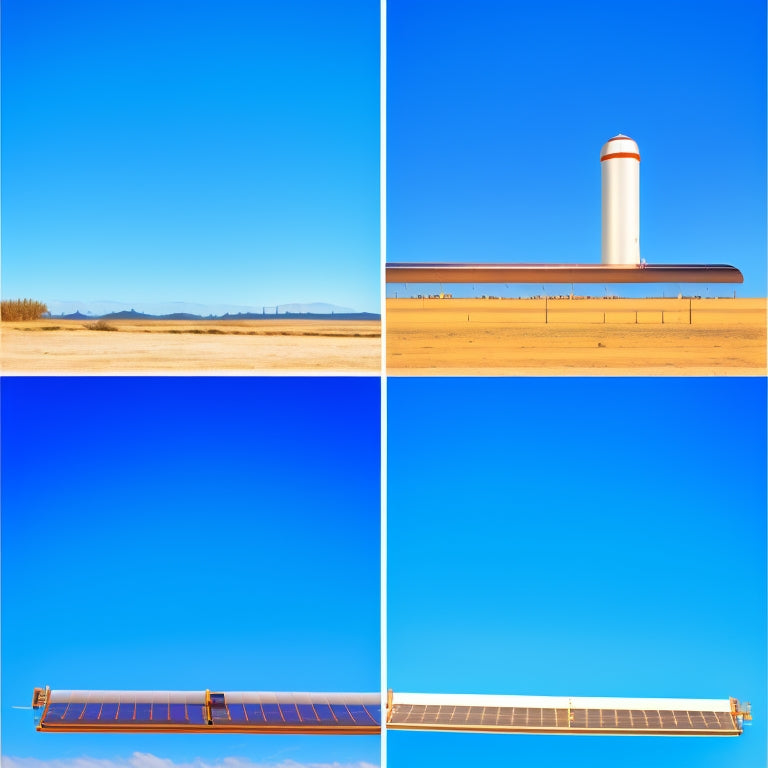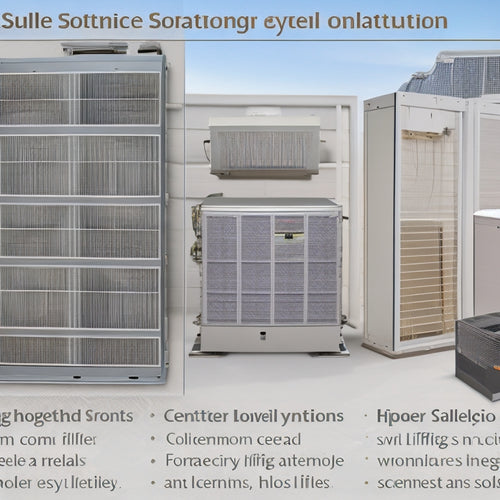
Top 5 Solar Thermal Collectors: Efficiency Face-Off
Share
You're about to compare the top 5 solar thermal collectors, where efficiency is key. Flat plate collectors rely on precise installation and maintenance, while evacuated tube collectors excel in cold and cloudy conditions with up to 70% thermal efficiency. Parabolic trough collectors take the lead with high concentration ratios and advanced tracking systems, reaching temperatures over 400°C. Direct flow collectors offer simplicity and lower costs, but compromise on efficiency. Heat pipe collectors operate on heat transfer principles, achieving higher temperatures and flexibility. Now, investigate how each collector's unique features impact your energy output and savings.
Key Takeaways
- Flat Plate Collectors offer ideal tilt and orientation for energy absorption, with regular maintenance ensuring peak performance.
- Evacuated Tube Collectors achieve up to 70% thermal efficiency, outperforming flat plate collectors in cold and cloudy conditions.
- Parabolic Trough Collectors excel with high concentration ratios, advanced solar tracking, and efficient heat transfer fluid for large-scale industrial applications.
- Direct Flow Collectors provide simplicity, lower costs, and ease of installation, making them suitable for space heating, swimming pool heating, and industrial process heat.
- Heat Pipe Collectors operate on the heat transfer principle, achieving higher temperatures and better performance than direct flow collectors in various applications.
Flat Plate Collector Efficiency
As you investigate the world of flat plate collectors, understanding their efficiency becomes vital.
You'll want to contemplate installation techniques that maximize energy absorption, such as ideal tilt and orientation angles. Regular maintenance practices, like cleaning and inspecting the collector, are also essential to guarantee peak performance.
Additionally, conducting an energy assessment and needs analysis can help identify the most efficient collector for your specific needs. Furthermore, evaluating solar panel system size based on total power consumption can also impact the overall efficiency of your flat plate collector.
Cost considerations, including upfront investment and long-term savings, should also be factored into your decision.
In application scenarios like residential water heating, flat plate collectors can provide significant energy savings.
By choosing the right collector and following best practices, you can enjoy reduced energy bills and a smaller carbon footprint.
With the right installation, maintenance, and application, flat plate collectors can be a reliable and efficient option for utilizing solar energy.
Evacuated Tube Collector Performance
You've likely considered flat plate collectors for your solar thermal needs, but now it's time to examine evacuated tube collectors, a popular alternative. These collectors consist of rows of glass tubes, each containing a heat pipe connected to a manifold.
The tubes are evacuated, providing excellent thermal insulation and minimizing heat loss. This design enables evacuated tube collectors to perform well in cold and cloudy conditions, making them suitable for various solar applications, including solar energy for EVs, which can reduce grid dependence and carbon footprint for EV charging stations.
Regular maintenance, including cleaning, is essential for peak performance and energy efficiency. Regarding efficiency, they can achieve up to 70% thermal efficiency, outperforming flat plate collectors in some cases.
Their flexibility and ability to operate at higher temperatures also make them ideal for industrial and commercial use.
Parabolic Trough Collector Analysis
Several types of solar thermal collectors are available, but parabolic trough collectors stand out for their high concentration ratio, which enables them to achieve temperatures exceeding 400°C.
When you opt for parabolic trough collectors, you'll benefit from their advanced solar tracking system, which guarantees the reflector always faces the sun, maximizing heat transfer. This design allows for a higher concentration of sunlight, resulting in increased efficiency.
To further optimize energy production, it's crucial to optimize solar panel array design and select energy-efficient equipment, minimizing losses and reducing operating costs.
The heat transfer fluid, typically oil or molten salt, flows through the receiver tube, absorbing the concentrated sunlight.
With precise temperature control and efficient heat transfer, parabolic trough collectors are ideal for large-scale industrial applications, providing a reliable source of clean energy.
Direct Flow Collector Comparison
Direct flow collectors emerge as a viable alternative to parabolic trough collectors, offering a distinct set of advantages and limitations.
You'll find direct flow advantages in their simplicity, lower costs, and ease of installation. They're ideal for direct flow applications like space heating, swimming pool heating, and industrial process heat.
Furthermore, adopting renewable energy sources like solar power can contribute to a cleaner, more sustainable future environmental responsibility and can even provide financial advantages through reduced operating costs and tax credits.
Direct flow maintenance is relatively easy, as the design allows for easy cleaning and replacement of components.
However, direct flow limitations include lower efficiency rates compared to parabolic trough collectors.
Despite this, advancements in direct flow technologies have improved their performance, making them a competitive option.
As you weigh your options, consider the trade-offs between efficiency, cost, and simplicity that direct flow collectors offer.
Heat Pipe Collector Showdown
Heat pipe collectors have emerged as a distinct class of solar thermal collectors, boasting unique characteristics that set them apart from other designs.
You'll notice they operate on the principle of heat transfer, where a working fluid evaporates and condenses, creating a temperature gradient. This gradient enables efficient heat transfer from the absorber to the heat exchanger, even over long distances.
As a result, heat pipe collectors can achieve higher temperatures and better performance than direct flow collectors. Their design also allows for a high degree of flexibility, making them suitable for a wide range of applications, such as renewable energy solutions for fleet owners.
In fact, solar panels on fleet vehicles can reduce fossil fuel reliance and carbon footprint, making them an attractive option for companies looking to go green.
When evaluating heat pipe collectors, consider factors such as the type of working fluid, the design of the heat exchanger, and the overall system efficiency.
Frequently Asked Questions
How Do Solar Thermal Collectors Perform in Low-Temperature Applications?
You'll find that solar thermal collectors' low-temperature efficiency relies on effective heat transfer, which can be optimized through advanced materials and designs, allowing you to utilize energy even in mild winter conditions or at night.
Can Solar Thermal Collectors Be Used With Heat Pumps?
As you commence on a quest for sustainable energy, you'll find that solar thermal collectors can harmoniously marry with heat pumps, creating hybrid systems that reveal collaboration through solar thermal integration, amplifying efficiency and freeing you from fossil fuel shackles.
What Are the Typical Maintenance Costs for Solar Thermal Collectors?
You'll find that typical maintenance costs for solar thermal collectors are relatively low, around $100-$300 per year, considering installation considerations and lifespan expectations of 20-30 years, allowing you to enjoy freedom from high energy bills.
Are Solar Thermal Collectors Suitable for Use in Cold Climates?
You're wondering if solar thermal collectors can thrive in chilly temps. The answer is yes, but you'll want to choose collector types designed for cold climates, considering factors like insulation, freeze protection, and system design to guarantee peak performance.
Can Solar Thermal Collectors Be Used for Cooling Purposes?
You can capture solar cooling by employing solar thermal collectors to generate thermal energy, which is then employed to power absorption chillers or evaporative cooling systems, providing an eco-friendly alternative to traditional cooling methods.
Related Posts
-

Why Solar HVAC Filters Revolutionize Home Energy Efficiency
By adopting solar HVAC filters, you're shifting your home's energy reliance from fossil fuels to clean, renewable sou...
-

7 Blockchain Tools for Home Energy Management
You can utilize blockchain technology to optimize your home's energy management through innovative solutions like blo...
-

10 Best Energy-Efficient External Hard Drives for Sustainable Offices
When it comes to sustainable offices, you need external hard drives that balance data storage needs with energy effic...


